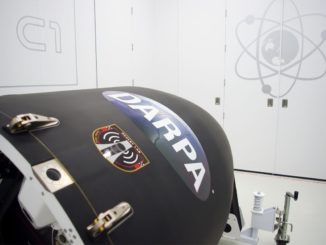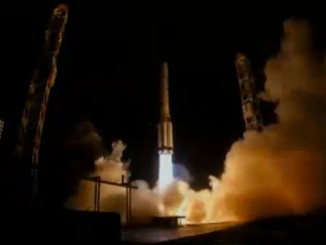A Russian military communications satellite launched Friday from the Baikonur Cosmodrome in Kazakhstan, riding a Proton rocket and Breeze M upper stage into orbit on just the second Proton flight this year, the lowest annual flight rate for Russia’s most powerful operational launcher since the 1960s.
The Proton rocket launched from the historic Russian-operated base in Kazakhstan at 0020 GMT Friday (7:20 p.m. EST Thursday) with the Russian military’s third Blagovest-series communications satellite.
The 191-foot-tall (58-meter) rocket lifted off from Baikonur at 6:20 a.m. local time Friday and turned toward the east-northeast, dropped its six-engine first stage two minutes into the flight, then fired two more stages in succession before giving way to the Breeze M upper stage.
The liquid-fueled Breeze M engine ignited four times to maneuver the Blagovest No. 13L spacecraft into a circular geosynchronous orbit more than 22,000 miles (nearly 36,000 kilometers) over the equator, using the upper stage’s restartable engine to climb to higher altitudes, and move to lower latitudes to match its orbital inclination to the equatorial plane.
Separation of the Blagovest No. 13L satellite was scheduled more than nine hours after liftoff, and Russian space agency head Dmitry Rogozin tweeted that the rocket placed the payload into the calculated orbit.
Russian Proton rocket-builder Khrunichev declared the launch successful in a press release, and the Russian Defense Ministry said the new relay satellite will be named Kosmos 2533, continuing the Russian military’s naming scheme for defense-related spacecraft.
Built at ISS Reshetnev’s satellite factory in Zheleznogorsk, Russia, the Blagovest No. 13L spacecraft is the third of four dual-purpose relay platforms ordered by the Russian Defense Ministry. The first Blagovest satellite, named Blagovest No. 11L, successfully launched on a Proton/Breeze M mission in August 2017, followed by Blagovest No. 12L earlier this year.
ISS Reshetnev says the Blagovest satellites provide high-speed internet, data communications, television and radio broadcasting, telephony and videoconferencing services. The satellite manufacturer issued press releases with details on the previous two Blagovest satellite launches, but released no statement marking Friday’s mission.
Friday’s Proton launch was just the second of 2018, the fewest Proton rocket launches in a year since 1966, the year after the rocket’s inaugural flight.
Multiple factors have led to the Proton’s low launch rate, including the emergence of new commercial launch providers like SpaceX and a spate of Proton/Breeze M launch failures. In the last few years, most launch contracts for large commercial geostationary satellites — which have declined overall as more operators look at smaller spacecraft sizes — have gone to SpaceX and Arianespace.
Fewer Russian military satellites are launching than before, and those that are built often fly on smaller rockets. One such example is Russia’s Glonass satellites, which used to launch three-at-a-time on Proton rockets, and now typically fly as single payloads on Soyuz boosters.
Proton rockets are marketed commercially by International Launch Services, a U.S.-based company that has sold Proton rocket missions on the global market since the 1990s. ILS Proton rockets were a force in the global launch business for two decades, but ILS has only a handful of commercial Proton missions in its backlog, and the company most recently conducted a commercial Proton launch in September 2017.
ILS has up to two commercial Proton flights scheduled for 2019. There are also up to five Proton missions planned for the Russian government, giving the Khrunichev up to seven Proton launches next year, according to a report published Saturday by the Russian state-run RIA Novosti news agency.
Alexei Varochko, head of Khrunichev, said in October that the company could schedule up to 10 launches next year, thanks to renewed support from Roscosmos, the Russian space agency. Only seven missions were identified in the RIA Novosti report Saturday, including the launch of the the Russian-German Spektr-RG X-ray telescope, the launch of another Blagovest military satellite, and the deployment of a French-built, Russian-owned commercial communications satellite named Yamal 601.
Other missions identified by RIA Novosti set for Proton launches in 2019 included two dual-payload launches — one carrying a pair of Russian Express telecom spacecraft, and another with a Eutelsat broadcasting satellite flying on the same rocket as Northrop Grumman’s first satellite servicing Mission Extension Vehicle.
RIA Novosti also reported the Canadian-owned Anik G2V commercial comsat and the long-delayed Russian MLM research module for the International Space Station could launch on Proton rockets in late 2019.
Khrunichev officials said in November that the company is assembling components for Russia’s second Angara A5 launcher, a heavy-lifter intended to replace the Proton. The rocket could be ready for shipment to the Plesetsk Cosmodrome in northern Russia in April for a launch some time next year, according to Khrunichev.
The maiden flight of Angara A5 rocket was successful in December 2014.
Friday’s Proton launch marked the 418th Proton flight since 1965, and the 104th to use the Proton M variant, which debuted in 2001.
Email the author.
Follow Stephen Clark on Twitter: @StephenClark1.



